Accommodation · Adventure Travel · Australia · Food and Drink · Hotels · Oceania · Regions · Speciality Travel · Travel Miscellany
Discover where the rainforest meets the Great Barrier Reef
If you drive south from Port Douglas, Australia, hugging the coast on the Captain Cook Highway towards Cairns, you arrive at the Thala Beach Nature Reserve – where the World Heritage Rainforest meets the Great Barrier Reef. The Nature Reserve Hotel is located high on a private peninsular jutting out into the Coral Sea overlooking two glorious deserted beaches and a rocky ‘fringing reef’ as they call it.
 The eco accommodation located in the 145 acre estate are beautifully presented individual lodges perched on the side of the headland providing stunning views over the rainforest towards broad bays.
The eco accommodation located in the 145 acre estate are beautifully presented individual lodges perched on the side of the headland providing stunning views over the rainforest towards broad bays.
 We discovered the hotel’s rock pools for swimming, constructed on four levels in what looks like a natural waterfall, until you find the buttons to turn them into a jacuzzi!
We discovered the hotel’s rock pools for swimming, constructed on four levels in what looks like a natural waterfall, until you find the buttons to turn them into a jacuzzi!
 Breakfast was in the circular open sided Ospreys Restaurant looking out over the canopy of the rainforest allowing us to enjoy our muesli of nuts and berries watching a dozen or so brightly coloured parrots, quite accurately called Rainbow Lorikeet, enjoying their breakfast of, well, nuts and berries.
Breakfast was in the circular open sided Ospreys Restaurant looking out over the canopy of the rainforest allowing us to enjoy our muesli of nuts and berries watching a dozen or so brightly coloured parrots, quite accurately called Rainbow Lorikeet, enjoying their breakfast of, well, nuts and berries.
 We decided to attempt the Marine Walk along the fringing reef and around the headland towards what we were promised would be the isolated Oak Beach. We were warned it should only be attempted at low tide and to be prepared for the terrain.
We decided to attempt the Marine Walk along the fringing reef and around the headland towards what we were promised would be the isolated Oak Beach. We were warned it should only be attempted at low tide and to be prepared for the terrain.
 We clambered over huge rocks forced to the surface by geological eruption and climbed around black petrified lava with holes bored into it doing a reasonable impression of Munch’s The Scream. We found impressive crystals of quartz too large to bring home and boulders eroded by the crashing waves close by.
An hour later and with some bruised legs and grazed shins we rounded the last vast rocks, looking as if they had been tossed there like a handful of pebbles, to reveal an immense expanse of deep empty beach stretching as far as the eye could see and farther than we could walk.
That evening we enjoyed a remarkably good dinner of crispy skinned Daintree Barramundi, red curry broth, coconut rice cake and young coconut sambal for Helene. And, seared Yellowfin Tuna, tomato kasundi, turmeric cauliflower purée, sweet potato and caramelised onion bhaji with roasted cashews for me. Finally retiring to our lodge to sleep until the rainforest dawn woke us.
We clambered over huge rocks forced to the surface by geological eruption and climbed around black petrified lava with holes bored into it doing a reasonable impression of Munch’s The Scream. We found impressive crystals of quartz too large to bring home and boulders eroded by the crashing waves close by.
An hour later and with some bruised legs and grazed shins we rounded the last vast rocks, looking as if they had been tossed there like a handful of pebbles, to reveal an immense expanse of deep empty beach stretching as far as the eye could see and farther than we could walk.
That evening we enjoyed a remarkably good dinner of crispy skinned Daintree Barramundi, red curry broth, coconut rice cake and young coconut sambal for Helene. And, seared Yellowfin Tuna, tomato kasundi, turmeric cauliflower purée, sweet potato and caramelised onion bhaji with roasted cashews for me. Finally retiring to our lodge to sleep until the rainforest dawn woke us.
 The following morning it was up early for breakfast with the parrots and a guided walk through the rainforest with Ranger Dave, a huge man in khaki shirt and shorts revealing calves like shoulders of beef with half a lifetime of bites, stings, cuts and scars above his size 12 boots. Three or four pairs of binoculars were slung around his neck and various hunting knives hung from his belt. He has worked with the owner of the Nature Reserve for 30 years, initially helping clear the area when it was mostly sugar cane and planting most of the palm trees that now tower above him.
The following morning it was up early for breakfast with the parrots and a guided walk through the rainforest with Ranger Dave, a huge man in khaki shirt and shorts revealing calves like shoulders of beef with half a lifetime of bites, stings, cuts and scars above his size 12 boots. Three or four pairs of binoculars were slung around his neck and various hunting knives hung from his belt. He has worked with the owner of the Nature Reserve for 30 years, initially helping clear the area when it was mostly sugar cane and planting most of the palm trees that now tower above him.
 Ranger Dave handed out binoculars and umbrellas to our small party. My goodness he knew his stuff, as you would do after 30 years of it I guess. It was a two hour masterclass of fascinating minutiae about our environment and its birds, insects and other creatures that make it their home.
But Ranger Dave became the most animated when he spotted the rare Tawny Frogmouth bird. After much pointing, gesticulating and shushing, all binoculars were trained on the owl looking bird sitting on its nest with its rear in the air displaying its tail feathers to us.
‘It may not look much, but it’s a spot,’ he whispered, and focussed his super photographic binocs-with-tripod on its tiny tawny derrière.
Ranger Dave handed out binoculars and umbrellas to our small party. My goodness he knew his stuff, as you would do after 30 years of it I guess. It was a two hour masterclass of fascinating minutiae about our environment and its birds, insects and other creatures that make it their home.
But Ranger Dave became the most animated when he spotted the rare Tawny Frogmouth bird. After much pointing, gesticulating and shushing, all binoculars were trained on the owl looking bird sitting on its nest with its rear in the air displaying its tail feathers to us.
‘It may not look much, but it’s a spot,’ he whispered, and focussed his super photographic binocs-with-tripod on its tiny tawny derrière.
 Some of the wildlife in the Nature Reserve was a little more unexpected. Ranger Dave fed the Wallabies every morning, sweet potato is their favourite.
Some of the wildlife in the Nature Reserve was a little more unexpected. Ranger Dave fed the Wallabies every morning, sweet potato is their favourite.
 Helene had a fine spot with an extremely rare Blue Tongued Lizard, and a tree climbing iguana about a metre long confidently ambled into breakfast one morning.
Helene had a fine spot with an extremely rare Blue Tongued Lizard, and a tree climbing iguana about a metre long confidently ambled into breakfast one morning.
 During our 10 month adventure so far, we have established that man is finally moving on from “the demolisher” to “the conserver” and for some species it’s just in time. As the transient guests to sites like Thala Nature Reserve, Mashpi Lodge in Ecuador and Amazonica in Peru we have been privileged to encounter the permanent guests in feathers, fur or scales – they are the owners not us, we are just visiting.
It may be a little scary at times, but we have a duty of care to respect the creatures we meet and their environment we visit, to add to it however we can, never to detract from it.
David Moore is Author of ‘Turning Left Around the World’. Published by Mirador and available from Amazon, it is an entertaining account of David and his wife’s travel adventures – often intriguing, frequently funny and occasionally tragic.
If you would like to be a guest blogger on A Luxury Travel Blog in order to raise your profile, please contact us.
During our 10 month adventure so far, we have established that man is finally moving on from “the demolisher” to “the conserver” and for some species it’s just in time. As the transient guests to sites like Thala Nature Reserve, Mashpi Lodge in Ecuador and Amazonica in Peru we have been privileged to encounter the permanent guests in feathers, fur or scales – they are the owners not us, we are just visiting.
It may be a little scary at times, but we have a duty of care to respect the creatures we meet and their environment we visit, to add to it however we can, never to detract from it.
David Moore is Author of ‘Turning Left Around the World’. Published by Mirador and available from Amazon, it is an entertaining account of David and his wife’s travel adventures – often intriguing, frequently funny and occasionally tragic.
If you would like to be a guest blogger on A Luxury Travel Blog in order to raise your profile, please contact us.
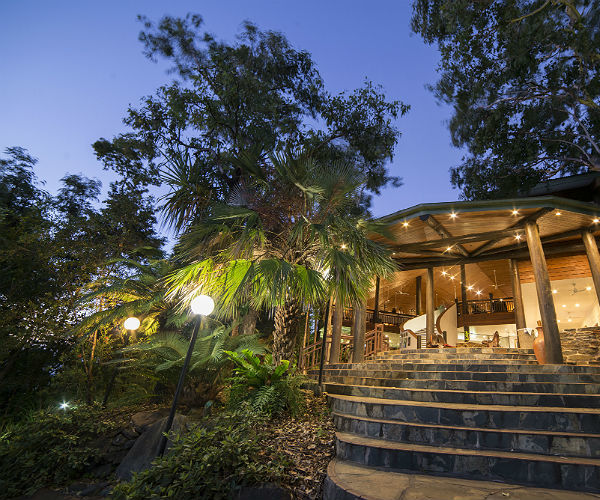 The eco accommodation located in the 145 acre estate are beautifully presented individual lodges perched on the side of the headland providing stunning views over the rainforest towards broad bays.
The eco accommodation located in the 145 acre estate are beautifully presented individual lodges perched on the side of the headland providing stunning views over the rainforest towards broad bays.
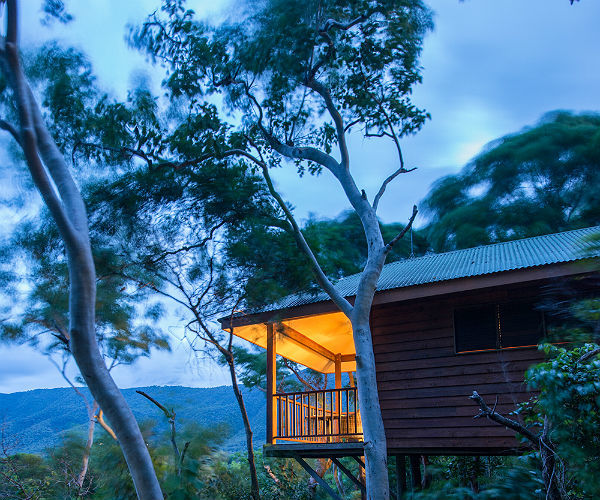 We discovered the hotel’s rock pools for swimming, constructed on four levels in what looks like a natural waterfall, until you find the buttons to turn them into a jacuzzi!
We discovered the hotel’s rock pools for swimming, constructed on four levels in what looks like a natural waterfall, until you find the buttons to turn them into a jacuzzi!
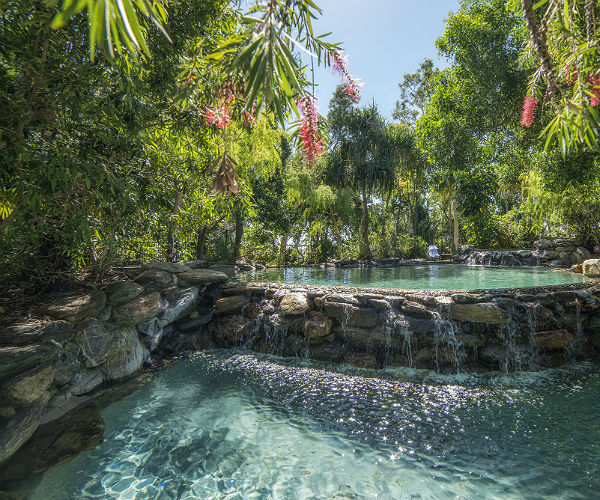 Breakfast was in the circular open sided Ospreys Restaurant looking out over the canopy of the rainforest allowing us to enjoy our muesli of nuts and berries watching a dozen or so brightly coloured parrots, quite accurately called Rainbow Lorikeet, enjoying their breakfast of, well, nuts and berries.
Breakfast was in the circular open sided Ospreys Restaurant looking out over the canopy of the rainforest allowing us to enjoy our muesli of nuts and berries watching a dozen or so brightly coloured parrots, quite accurately called Rainbow Lorikeet, enjoying their breakfast of, well, nuts and berries.
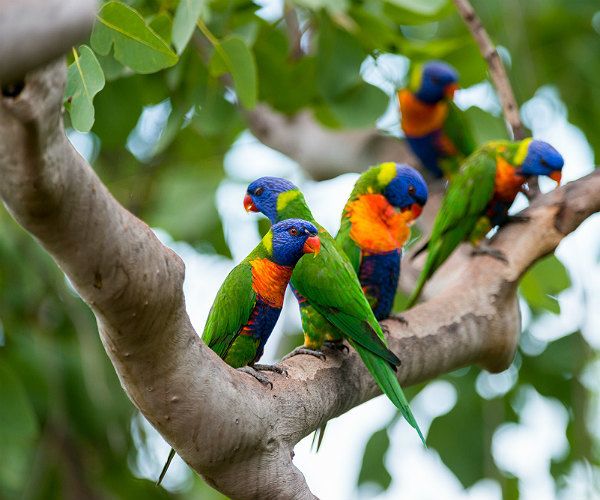 We decided to attempt the Marine Walk along the fringing reef and around the headland towards what we were promised would be the isolated Oak Beach. We were warned it should only be attempted at low tide and to be prepared for the terrain.
We decided to attempt the Marine Walk along the fringing reef and around the headland towards what we were promised would be the isolated Oak Beach. We were warned it should only be attempted at low tide and to be prepared for the terrain.
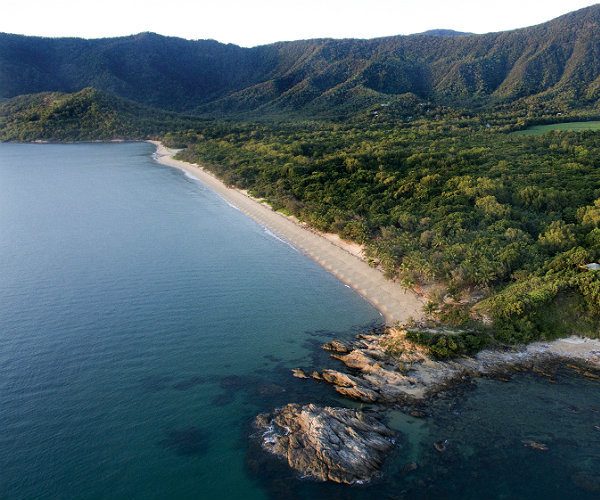 We clambered over huge rocks forced to the surface by geological eruption and climbed around black petrified lava with holes bored into it doing a reasonable impression of Munch’s The Scream. We found impressive crystals of quartz too large to bring home and boulders eroded by the crashing waves close by.
An hour later and with some bruised legs and grazed shins we rounded the last vast rocks, looking as if they had been tossed there like a handful of pebbles, to reveal an immense expanse of deep empty beach stretching as far as the eye could see and farther than we could walk.
That evening we enjoyed a remarkably good dinner of crispy skinned Daintree Barramundi, red curry broth, coconut rice cake and young coconut sambal for Helene. And, seared Yellowfin Tuna, tomato kasundi, turmeric cauliflower purée, sweet potato and caramelised onion bhaji with roasted cashews for me. Finally retiring to our lodge to sleep until the rainforest dawn woke us.
We clambered over huge rocks forced to the surface by geological eruption and climbed around black petrified lava with holes bored into it doing a reasonable impression of Munch’s The Scream. We found impressive crystals of quartz too large to bring home and boulders eroded by the crashing waves close by.
An hour later and with some bruised legs and grazed shins we rounded the last vast rocks, looking as if they had been tossed there like a handful of pebbles, to reveal an immense expanse of deep empty beach stretching as far as the eye could see and farther than we could walk.
That evening we enjoyed a remarkably good dinner of crispy skinned Daintree Barramundi, red curry broth, coconut rice cake and young coconut sambal for Helene. And, seared Yellowfin Tuna, tomato kasundi, turmeric cauliflower purée, sweet potato and caramelised onion bhaji with roasted cashews for me. Finally retiring to our lodge to sleep until the rainforest dawn woke us.
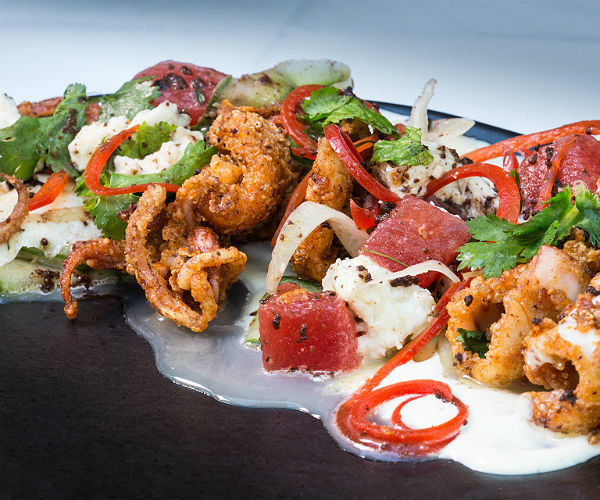 The following morning it was up early for breakfast with the parrots and a guided walk through the rainforest with Ranger Dave, a huge man in khaki shirt and shorts revealing calves like shoulders of beef with half a lifetime of bites, stings, cuts and scars above his size 12 boots. Three or four pairs of binoculars were slung around his neck and various hunting knives hung from his belt. He has worked with the owner of the Nature Reserve for 30 years, initially helping clear the area when it was mostly sugar cane and planting most of the palm trees that now tower above him.
The following morning it was up early for breakfast with the parrots and a guided walk through the rainforest with Ranger Dave, a huge man in khaki shirt and shorts revealing calves like shoulders of beef with half a lifetime of bites, stings, cuts and scars above his size 12 boots. Three or four pairs of binoculars were slung around his neck and various hunting knives hung from his belt. He has worked with the owner of the Nature Reserve for 30 years, initially helping clear the area when it was mostly sugar cane and planting most of the palm trees that now tower above him.
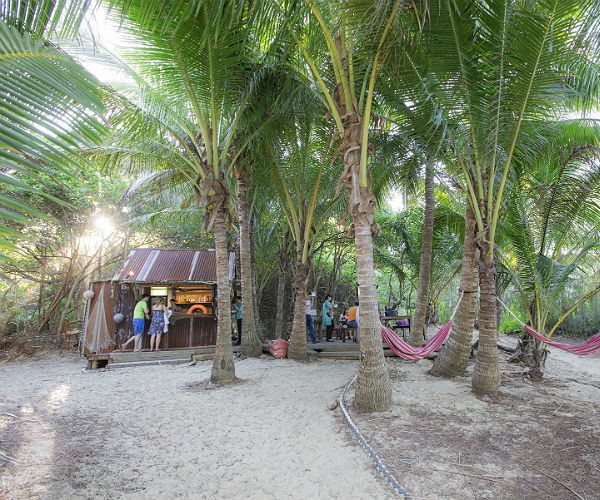 Ranger Dave handed out binoculars and umbrellas to our small party. My goodness he knew his stuff, as you would do after 30 years of it I guess. It was a two hour masterclass of fascinating minutiae about our environment and its birds, insects and other creatures that make it their home.
But Ranger Dave became the most animated when he spotted the rare Tawny Frogmouth bird. After much pointing, gesticulating and shushing, all binoculars were trained on the owl looking bird sitting on its nest with its rear in the air displaying its tail feathers to us.
‘It may not look much, but it’s a spot,’ he whispered, and focussed his super photographic binocs-with-tripod on its tiny tawny derrière.
Ranger Dave handed out binoculars and umbrellas to our small party. My goodness he knew his stuff, as you would do after 30 years of it I guess. It was a two hour masterclass of fascinating minutiae about our environment and its birds, insects and other creatures that make it their home.
But Ranger Dave became the most animated when he spotted the rare Tawny Frogmouth bird. After much pointing, gesticulating and shushing, all binoculars were trained on the owl looking bird sitting on its nest with its rear in the air displaying its tail feathers to us.
‘It may not look much, but it’s a spot,’ he whispered, and focussed his super photographic binocs-with-tripod on its tiny tawny derrière.
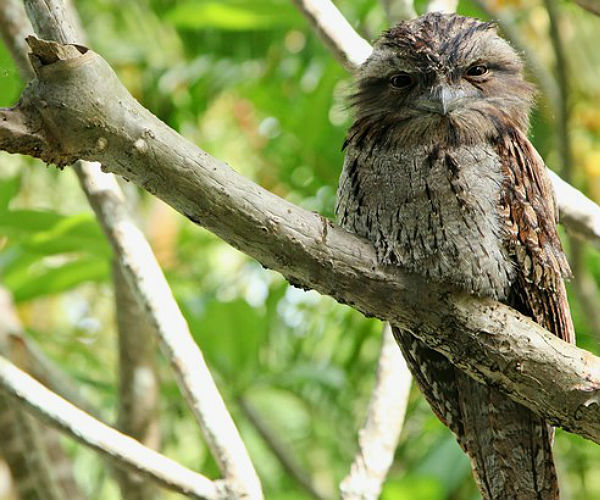 Some of the wildlife in the Nature Reserve was a little more unexpected. Ranger Dave fed the Wallabies every morning, sweet potato is their favourite.
Some of the wildlife in the Nature Reserve was a little more unexpected. Ranger Dave fed the Wallabies every morning, sweet potato is their favourite.
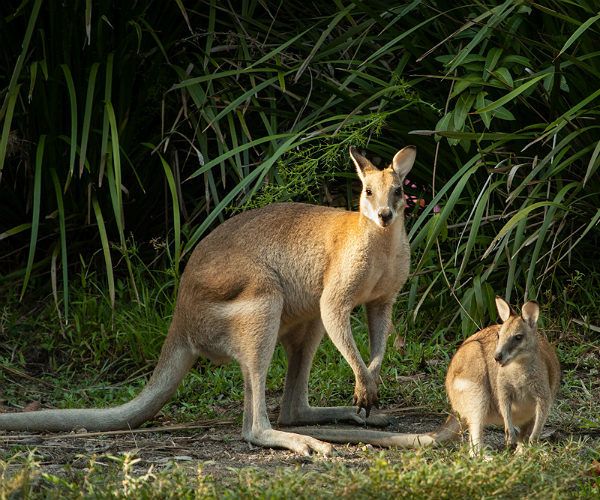 Helene had a fine spot with an extremely rare Blue Tongued Lizard, and a tree climbing iguana about a metre long confidently ambled into breakfast one morning.
Helene had a fine spot with an extremely rare Blue Tongued Lizard, and a tree climbing iguana about a metre long confidently ambled into breakfast one morning.
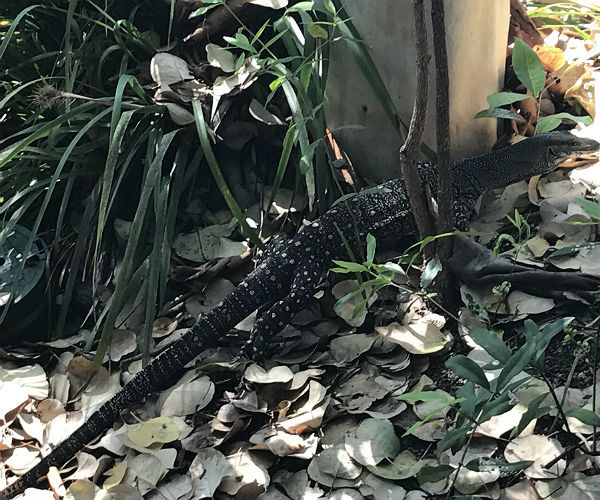 During our 10 month adventure so far, we have established that man is finally moving on from “the demolisher” to “the conserver” and for some species it’s just in time. As the transient guests to sites like Thala Nature Reserve, Mashpi Lodge in Ecuador and Amazonica in Peru we have been privileged to encounter the permanent guests in feathers, fur or scales – they are the owners not us, we are just visiting.
It may be a little scary at times, but we have a duty of care to respect the creatures we meet and their environment we visit, to add to it however we can, never to detract from it.
David Moore is Author of ‘Turning Left Around the World’. Published by Mirador and available from Amazon, it is an entertaining account of David and his wife’s travel adventures – often intriguing, frequently funny and occasionally tragic.
If you would like to be a guest blogger on A Luxury Travel Blog in order to raise your profile, please contact us.
During our 10 month adventure so far, we have established that man is finally moving on from “the demolisher” to “the conserver” and for some species it’s just in time. As the transient guests to sites like Thala Nature Reserve, Mashpi Lodge in Ecuador and Amazonica in Peru we have been privileged to encounter the permanent guests in feathers, fur or scales – they are the owners not us, we are just visiting.
It may be a little scary at times, but we have a duty of care to respect the creatures we meet and their environment we visit, to add to it however we can, never to detract from it.
David Moore is Author of ‘Turning Left Around the World’. Published by Mirador and available from Amazon, it is an entertaining account of David and his wife’s travel adventures – often intriguing, frequently funny and occasionally tragic.
If you would like to be a guest blogger on A Luxury Travel Blog in order to raise your profile, please contact us.Did you enjoy this article?
Receive similar content direct to your inbox.


This looks very similar to the hotel we stayed at in Daintree. It also had balconies that are level with the canopy of trees. This part of Australia really is a nature-lovers dream. We might try this lodge for next time we visit the Great Barrier Reef.
Thanks for the comment Raff…
Yes, I would recommend it; great environment (do try the beach walk when the tide is out), excellent food and wonderful excursions with Ranger Dave
Happy Travels
David
David, I can see that this very special destination made a lasting impression on you. Would it be up there in your Top Five locations after your travels around the globe? And perhaps, a harder question, taking up your point about Man’s shift from Demolisher to Conserver where would you most like to return to in five years time – hoping to see environmental progress?
Hi Jane
Yes Thala Beach was a very special place and is certainly in our Top 5 along with Mashpi Lodge – Ecuador, Amazonica – Peru, Siem Reap – Cambodia, the Galapagos Islands and Kanazawa – Japan…
That’s six! I thought it would be difficult
I’m glad you picked up on the Demolisher to Conserver point – I would love to return to Fiji and Australia in a few years time in the hope that the reefs and coral are thriving, but that may be too optimistic, we’ll see
Happy Travels
David